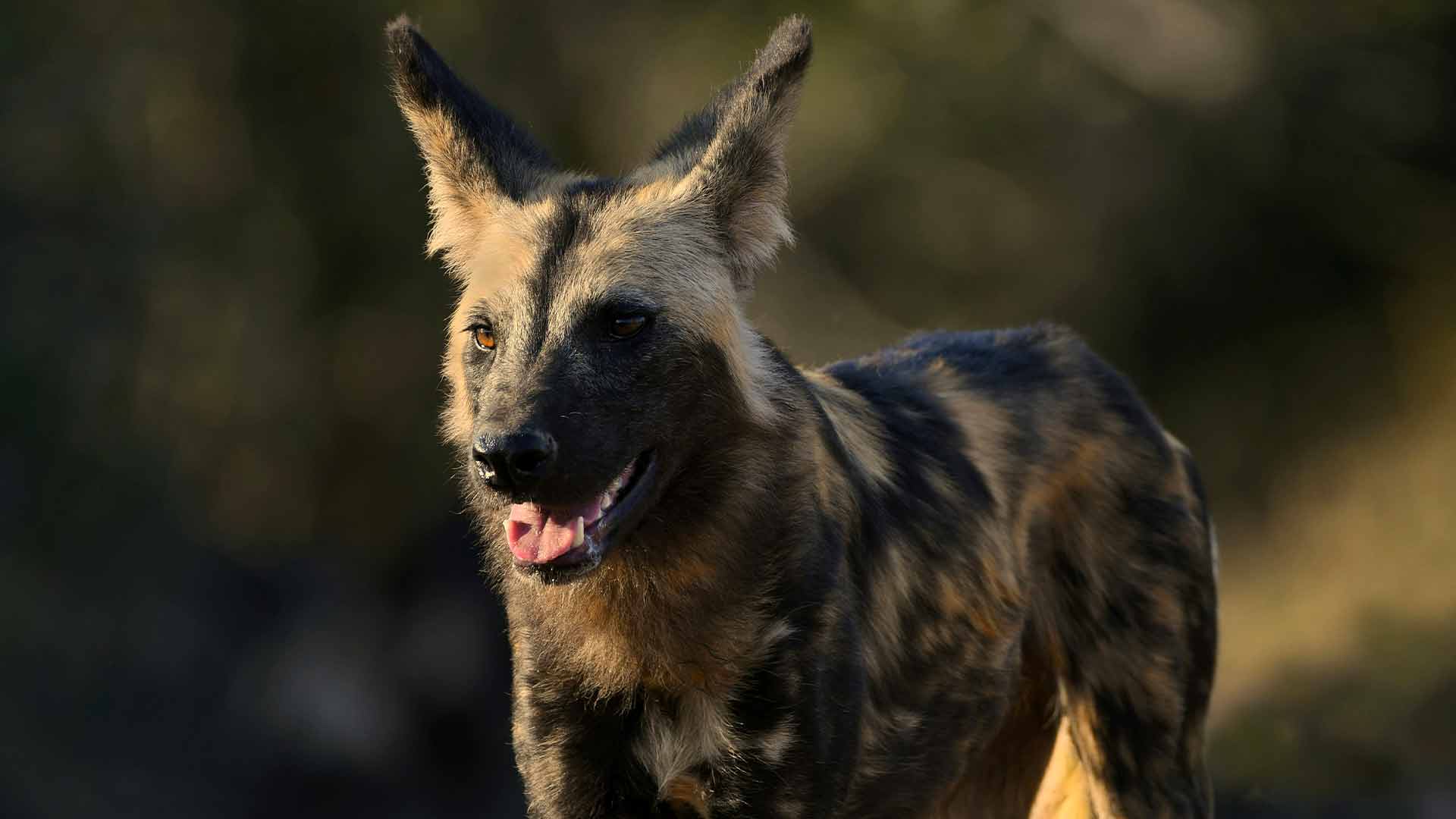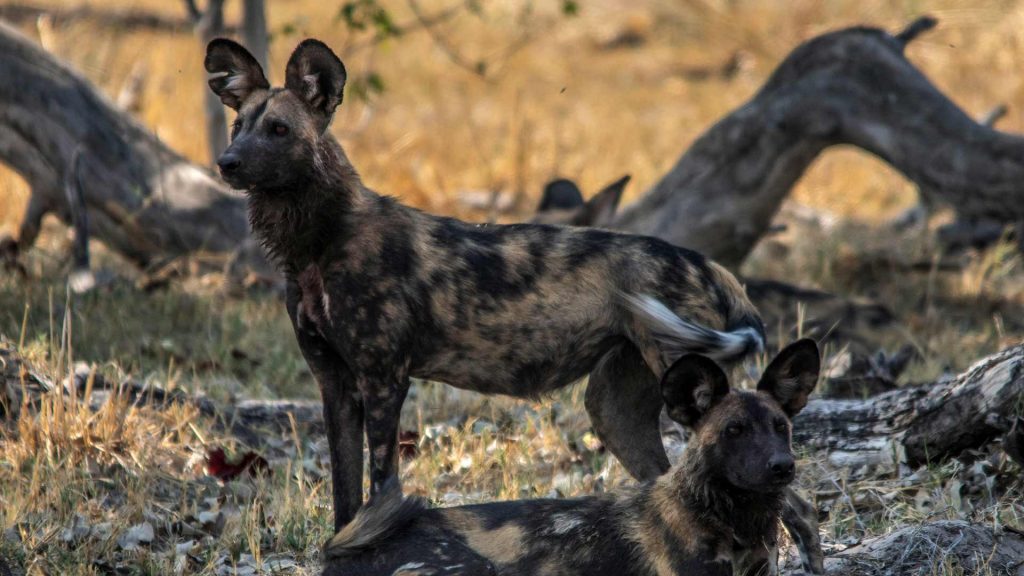African Wild Dog
The African wild dog (Lycaon pictus), also known as the “painted wolf”, is an endangered carnivore with large, rounded ears and a colorful coat. These social animals live in packs and are among Africa’s most efficient hunters. Learn about their behaviour, physical description, habitat and geographical distribution.

Overview
The African wild dog, scientifically known as Lycaon pictus, is one of the continent’s most fascinating and endangered carnivores. Also known as the painted wolf due to its distinctive, colorful coat, the African wild dog is renowned for its highly social behavior, exceptional hunting skills, and the intricate bonds within its packs.
African wild dogs are known for their unique appearance, characterized by irregular patches of black, brown, white, and yellow fur, which provide excellent camouflage in their natural habitats. Their scientific name, Lycaon pictus, translates to “painted wolf,” reflecting their striking coat patterns. These animals are social and live in packs that can range from 6 to 20 individuals, although larger packs have been observed. The pack structure is complex and typically consists of a dominant breeding pair and their offspring, along with other related or unrelated individuals.
Species in Africa
There is only one species of African wild dog, but they exhibit regional variations in coat coloration and size, which are adaptations to the diverse habitats they occupy across the continent. Despite these variations, all African wild dogs share the same fundamental physical characteristics and social behaviors.
- East African Wild Dog: Found in countries like Kenya and Tanzania, these wild dogs often have more distinct and brighter patches of color in their coat.
- Southern African Wild Dog: Inhabiting regions in Botswana, Namibia, Zimbabwe, and South Africa, these dogs may have slightly more muted and blended coloration, adapting to the varied landscapes of the region.
- West African Wild Dog: Less studied due to their highly endangered status and fragmented populations, these wild dogs show adaptations suited to the different ecological zones in West Africa.
Scientific Classification
- Kingdom: Animalia
- Phylum: Chordata
- Class: Mammalia
- Order: Carnivora
- Family: Canidae
- Genus: Lycaon
- Species: Lycaon pictus
Description
The African wild dog, or Lycaon pictus, is a unique and highly specialized predator, easily recognizable by its distinct appearance and coloration. Each individual has a unique coat pattern, making them identifiable from one another, much like human fingerprints.
Size
African wild dogs are medium-sized canids. Adult males and females typically weigh between 18 to 36 kilograms (40 to 79 pounds) and stand about 60 to 75 centimeters (24 to 30 inches) tall at the shoulder. Their body length ranges from 75 to 110 centimeters (30 to 43 inches), excluding the tail, which adds another 30 to 40 centimeters (12 to 16 inches).
Coat
The most striking feature of the African wild dog is its coat, which is a patchwork of black, brown, white, and yellow fur. This mottled pattern provides excellent camouflage in their natural habitats. The fur is short and sparse compared to other canids, which helps them stay cool in the hot African climate. The exact pattern and coloration are unique to each individual, aiding in identification and social interactions within the pack.
Head and Ears
African wild dogs have large, rounded ears that are not only characteristic but also functional. These ears help with thermoregulation and enhance their hearing, which is crucial for hunting and communication. Their eyes are adapted for excellent vision, especially in low light conditions, aiding their crepuscular and nocturnal hunting activities. They possess a strong, broad muzzle with a powerful jaw and sharp, carnivorous teeth designed for tearing flesh.
Legs and Tail
The legs of African wild dogs are long, slender, and built for endurance. Their muscular build allows them to sustain high speeds over long distances, essential for their hunting strategy. They are capable of running at speeds up to 60 kilometers per hour (37 miles per hour) for several kilometers. The tail is bushy and typically white-tipped, which may aid in visual communication among pack members during hunts and other group activities.

Behaviour, Diet, Reproduction, and Lifespan
Behaviour
African wild dogs are highly social animals that live in packs typically consisting of 6 to 20 individuals, although larger packs have been observed.
- Social Structure: Packs are led by a dominant breeding pair, often referred to as the alpha male and female. The rest of the pack consists of their offspring and sometimes other related or unrelated individuals. Social bonds within the pack are strong, with cooperative care for the young and collaborative hunting strategies.
- Hunting and Feeding: African wild dogs are cooperative hunters, known for their incredible stamina and coordinated pack tactics. They primarily hunt medium-sized ungulates such as impalas, gazelles, and wildebeests. Hunts are typically conducted in the early morning and late afternoon to avoid the heat of the day.
- Communication: Communication within the pack is vital for their survival and success. They use a variety of vocalizations, including chirps, twittering calls, and a distinctive “hoo” sound to keep in contact with each other. Body language and scent marking also play significant roles in maintaining pack cohesion and territory.
Diet
African wild dogs are obligate carnivores, relying entirely on meat for their nutrition. They are efficient hunters with a high success rate, often consuming their prey quickly to avoid scavengers.
- Prey: Their diet mainly consists of antelope species such as impalas, gazelles, and occasionally larger prey like wildebeests and zebras. They may also hunt smaller animals, including hares and rodents, when necessary.
- Feeding Behavior: After a successful hunt, the pack regroups and the dominant individuals feed first, followed by the rest of the pack. They often regurgitate food for pups and other members who did not participate in the hunt.
Reproduction and Lifespan
The alpha female usually gives birth once a year after a gestation period of about 70 days. Litters typically consist of 6 to 10 pups, but can sometimes be larger. Pups are born in a den and are cared for by the entire pack.
Both the alpha pair and subordinate pack members participate in raising the young. The pack brings food to the den and guards the pups diligently. The pups are weaned at around 10 weeks but remain dependent on the pack for several more months.
In the wild, African wild dogs live for about 10 to 12 years. Their lifespan can be longer in captivity due to the absence of threats such as predators and diseases.
Habitat and Geographical Distribution
African wild dogs inhabit a variety of ecosystems across sub-Saharan Africa, including savannas, grasslands, woodlands, and semi-desert areas. They require large territories to support their high-energy hunting lifestyle and social structure.
In Tanzania, African wild dogs are found in the Serengeti National Park and Selous Game Reserve. These protected areas provide vast, open spaces and abundant prey essential for their survival.
In Botswana, the Okavango Delta and Chobe National Park are key habitats. The Okavango Delta’s unique wetland environment supports a healthy wild dog population, while Chobe offers diverse landscapes that cater to their needs.
In Zimbabwe, Hwange National Park is a significant refuge for wild dogs. The park’s mixed woodland and grassland habitats provide excellent hunting grounds.
In South Africa, Kruger National Park and Madikwe Game Reserve are notable areas. Kruger’s extensive area and diverse ecosystems are ideal for sustaining wild dog packs, and Madikwe has seen successful reintroduction programs.
In Kenya, African wild dogs are found in Laikipia and the Maasai Mara. These regions support robust wildlife populations and provide the necessary space for wild dogs to roam and hunt.
In Namibia, Etosha National Park and the surrounding conservancies are important for wild dog conservation. The arid conditions and open landscapes of Etosha are suitable for their hunting strategies.
In Zambia, South Luangwa National Park and Kafue National Park host wild dog populations. These parks offer vast, undisturbed areas crucial for their survival.
In Mozambique, Gorongosa National Park has seen a resurgence in wild dog populations thanks to intensive conservation efforts. The park’s varied habitats support a diverse prey base.
In Malawi, Liwonde National Park is an emerging habitat for African wild dogs due to successful reintroduction efforts. The park’s diverse ecosystems are conducive to supporting stable packs.
In Angola, wild dogs can be found in the Luengue-Luiana National Park, part of the Kavango-Zambezi Transfrontier Conservation Area. This region’s expansive wilderness provides critical habitats for their survival.
Conservation
African wild dogs are listed as endangered, with fewer than 6,000 individuals remaining in the wild. Conservation efforts focus on habitat protection, mitigating human-wildlife conflict, disease management, and community engagement.
Facts
Interesting facts about The African Wild Dog.
African wild dogs are called painted wolves due to their colorful and mottled coat patterns, which resemble a painter’s palette. This unique coloration helps with camouflage in their natural habitat.
African wild dogs are highly successful hunters, with a success rate of about 80% in their hunts, making them one of the most efficient predators in the animal kingdom.
The entire pack participates in raising the pups, providing food through regurgitation and guarding the den. This cooperative care ensures higher survival rates for the offspring.
Lions and hyenas are the primary natural predators of African wild dogs. They often compete for the same prey and may kill wild dogs to reduce competition.
African wild dogs can travel up to 50 kilometers (31 miles) in a single day in search of prey. Their large home ranges, which can span over 1,000 square kilometers (386 square miles), are necessary to support their dietary needs.
Wild dogs communicate through vocalizations such as high-pitched twitters, body language, and scent marking. These methods help maintain pack cohesion and coordinate hunting activities.
African wild dogs hunt cooperatively, often using their endurance to exhaust prey during long chases. They rely on their keen senses and pack coordination to bring down animals, typically targeting medium-sized ungulates like impalas and gazelles.
African wild dogs have several unique characteristics that distinguish them from other canids, including their large, rounded ears, specialized teeth for shearing meat, and highly social pack structure. They are also the only canid species with only four toes on each foot, as opposed to five.
The large, rounded ears of African wild dogs serve multiple purposes. They enhance hearing, which is crucial for detecting prey and communication within the pack. Additionally, these ears help dissipate heat, assisting in thermoregulation in the hot African climate.
In the wild, African wild dogs typically live for about 10 years due to threats like disease and predation. In captivity, where they are protected from such dangers and receive regular veterinary care, they can live up to 15 years.
Other Animals
Explore fauna in Africa.






